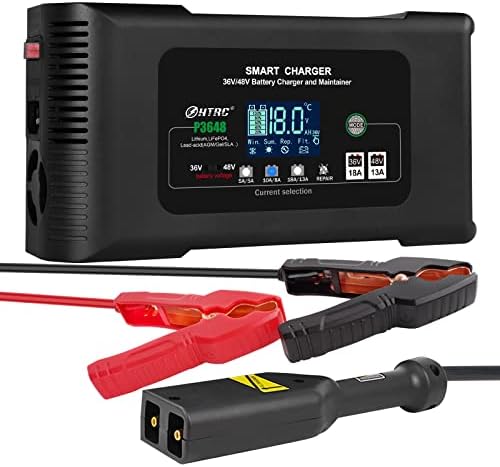Using a 48V charger with a 36V battery can potentially damage the battery due to overcharging. The higher voltage can cause overheating and shorten the battery’s lifespan.
Using a charger with a higher voltage than the battery’s rating can lead to overcharging, which may damage the battery cells and result in reduced capacity and lifespan. It’s essential to match the charger’s voltage to the battery’s voltage to ensure safe and efficient charging.
Also, using a mismatched charger can void the battery’s warranty. It’s crucial to always use a charger that matches the voltage of the battery to avoid potential damage and maintain the battery’s performance and longevity.
Understanding The Basics Of Voltage In Batteries
Before delving into the potential consequences of using a 48V charger with a 36V battery, it’s crucial to understand the fundamentals of voltage in battery systems. Voltage serves as a measure of electrical potential difference in a circuit, indicating the force that drives current through a conductor. In the context of batteries, voltage determines the power output and compatibility with specific devices or charging mechanisms.
Explaining Voltage In Battery Systems
Voltage, denoted as V, is a crucial aspect of battery technology, representing the potential energy difference between the positive and negative terminals of the battery. It directly influences the performance and operation of electrical devices, influencing factors such as speed, torque, and overall power consumption.
Differences Between 36v And 48v Batteries
36V and 48V batteries vary in their voltage outputs, affecting their suitability for distinct applications. A 36V battery is designed to deliver a specific level of power, while a 48V battery offers a higher voltage output and, consequently, increased potential energy. These differences are critical when considering the compatibility of charging mechanisms and the overall performance of the battery-powered system.
Impact Of Using A 48v Charger With A 36v Battery
When it comes to charging an e-bike or any electronic device, using the correct voltage charger is crucial to ensure the safety and longevity of the battery. Many e-bike owners might wonder what could happen if they use a 48V charger with a 36V battery. Let’s explore the potential risks, impact on battery performance, and longevity of such a mismatch.
Potential Risks And Dangers
Using a 48V charger with a 36V battery can pose significant risks and dangers to both the battery and the e-bike. The overcharging caused by the higher voltage can lead to overheating, increased risk of fire, and even battery explosion. It can also cause damage to the internal electronic components of the e-bike, posing a safety threat to riders and bystanders.
Effects On Battery Performance And Longevity
The use of a 48V charger with a 36V battery can have detrimental effects on the battery’s performance and longevity. Overcharging can lead to a shortened lifespan of the battery, decreased capacity, and reduced overall performance. The mismatch in voltage can also cause imbalance among the battery cells, further impacting its ability to hold a charge and deliver power efficiently.
Why Matching Charger And Battery Voltage Matters
Choosing the right charger for your battery is crucial to ensure the safety and longevity of your electrical components. Using a 48V charger with a 36V battery can lead to potential risks and inefficiencies. Let’s explore the importance of compatibility and the risks associated with mismatching voltage.
Importance Of Compatibility
When it comes to charging your battery, matching the voltage of the charger with the voltage of the battery is essential. Using a charger with a different voltage can lead to overcharging or undercharging, both of which can damage the battery cells and reduce their overall lifespan. It’s crucial to ensure that the charger and battery voltage are compatible to maintain the health and performance of the battery.
Exploring The Risks Of Mismatching
Mismatching the charger and battery voltage can pose several risks, including:
- Overcharging the battery, leading to overheating and potential fire hazards
- Undercharging the battery, which can result in decreased capacity and performance
- Potential damage to the battery cells, reducing its overall lifespan
- Increased risk of electrical malfunctions and component failures
Ensuring that the charger and battery voltage are properly matched is essential for maintaining the safety and efficiency of your electrical system.
Factors To Consider When Charging A Battery
When it comes to charging a battery, it’s crucial to consider various factors to ensure optimal performance and safety. From voltage and current to the charging process and safety precautions, each aspect plays a significant role in maintaining the health and longevity of the battery. Let’s delve into the key factors to consider when charging a battery to understand the potential impact of using a 48V charger with a 36V battery.
Voltage
The voltage of the charger must match or be compatible with the voltage rating of the battery. Using a 48V charger with a 36V battery can result in overcharging, leading to excessive heat generation and potential damage to the battery cells.
Current
Ensuring that the charger’s current output aligns with the battery’s specifications is essential. A mismatch in current can lead to inefficient charging, affecting the overall performance and lifespan of the battery.
Charging Process
Understanding the recommended charging process for a specific battery type is crucial. Different chemistries such as lead-acid, lithium-ion, and nickel-based batteries require distinct charging algorithms to optimize their performance and longevity.
Safety Precautions And Best Practices
Implementing safety measures during the battery charging process is paramount. From ensuring proper ventilation to avoiding overcharging and monitoring the charging process, adhering to best practices helps prevent potential risks such as thermal runaway and cell damage.
Exploring Alternatives For Charging A 36v Battery
Suitable Charger Options
When using a 36V battery, it’s crucial to ensure that the charger is compatible to avoid potential damage. Using a 48V charger with a 36V battery can lead to overcharging, overheating, and ultimately decrease the lifespan of the battery. However, there are suitable charger options available that can effectively charge a 36V battery without causing any harm.
- Look for a charger specifically designed for 36V batteries to ensure optimal charging performance and safety.
- Consider a smart charger with built-in protections to prevent overcharging and overheating.
- Ensure that the charger’s output voltage matches the battery’s requirements to avoid any potential damage.
Conversion Or Modification Considerations
For those considering alternative charging methods for a 36V battery, conversion or modification might be a viable option. It’s crucial to carefully consider the conversion or modification process to ensure the safety and effectiveness of the new charging setup. Here are some important considerations:
- Consult with a professional technician or electrician who has experience in battery systems to assess the feasibility of modifying the charger or battery system.
- Explore the option of using a voltage converter to adjust the voltage output of the 48V charger to match the 36V battery’s requirements.
- Consider custom modifications or specialized chargers designed for specific battery configurations, ensuring compatibility and safety.

Credit: no. co
Optimizing Battery Charging Efficiency
When it comes to charging your battery, using the correct charger voltage is crucial for maintaining the optimal performance and longevity of the battery. In this blog post, we will delve into the implications of using a 48V charger with a 36V battery, specifically focusing on the long-term consequences and understanding the optimal charging parameters.
Understanding The Optimal Charging Parameters
Charging a 36V battery with a 48V charger can potentially lead to overcharging, which may cause irreversible damage to the battery cells. The optimal charging parameters for a 36V battery require a charger with a voltage output that matches the battery’s specifications. Using a higher voltage charger can result in excessive current flow, leading to overheating and decreased battery lifespan.
Long-term Implications Of Using The Correct Charger Voltage
By using the correct charger voltage for your 36V battery, you can ensure that the battery is charged efficiently and safely. This not only extends the battery’s lifespan but also maintains its performance over time. Consistent use of the correct charger voltage contributes to the overall health of the battery and reduces the risk of premature degradation.
Can I Charge A 36v Battery With A 42v Charger?
No, it is not safe to charge a 36V battery with a 42V charger. Using the incorrect voltage can damage the battery. It is important to match the charger voltage to the battery voltage for safe and effective charging.
Can I Use A 48v Battery On A 36v Motor?
Yes, but it may cause overheating or damage. Check if the motor is compatible.
Can I Use a 54v Charger For a 36v Battery?
No, using a 54V charger for a 36V battery is not recommended. It may cause damage to the battery or the device being charged. Stick to the recommended voltage for optimal performance and safety.
Can I Charge A 36v Battery With A 24v Charger?
No, a 24V charger is not suitable for charging a 36V battery. It may cause damage and pose a safety risk.
Conclusion
To sum it up, using a 48V charger with a 36V battery can damage the battery. Make sure you use the correct charger to avoid potential hazards. It’s essential to prioritize safety and invest in the right equipment for your battery needs. Take the necessary precautions to prolong the lifespan of your battery.



